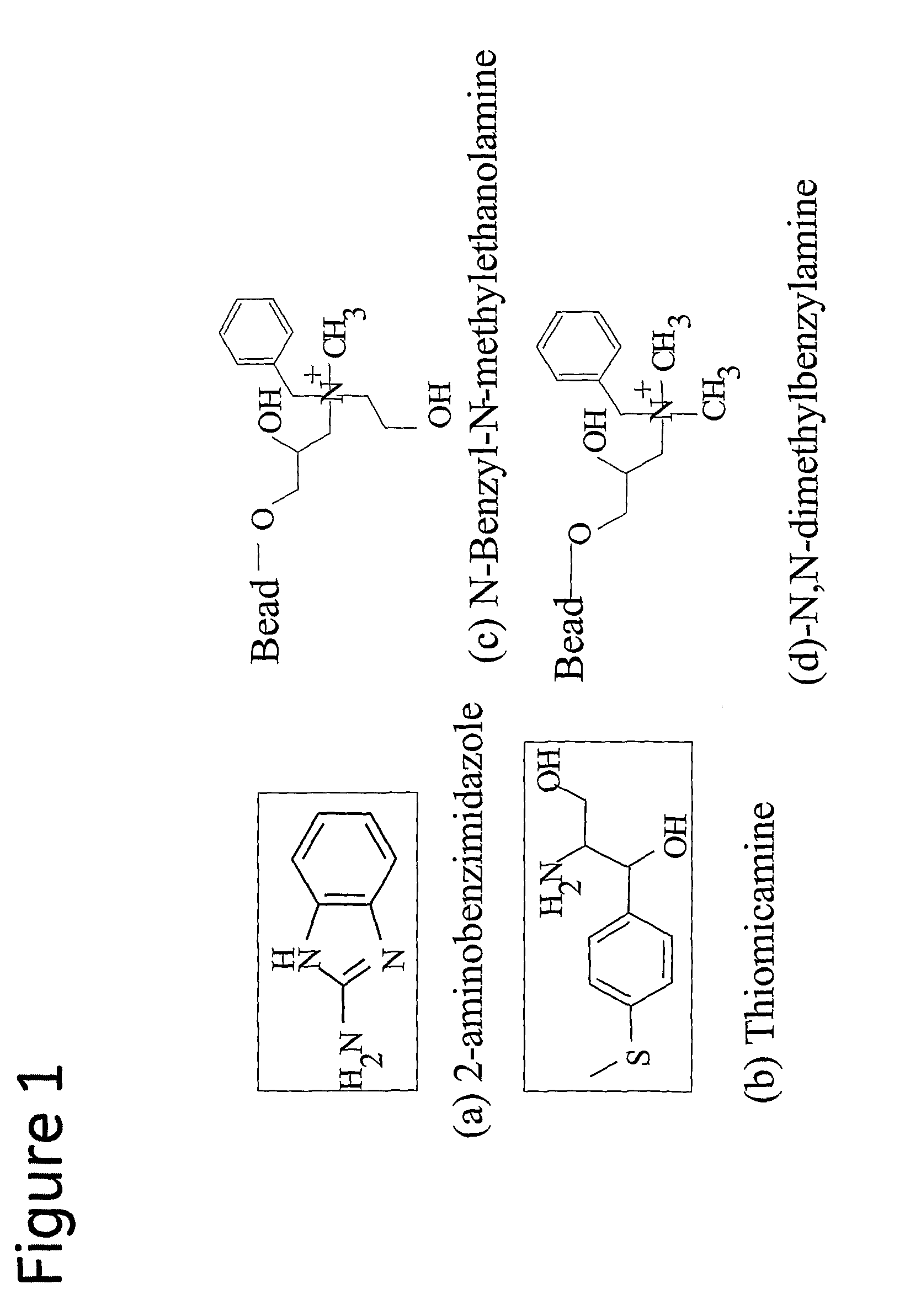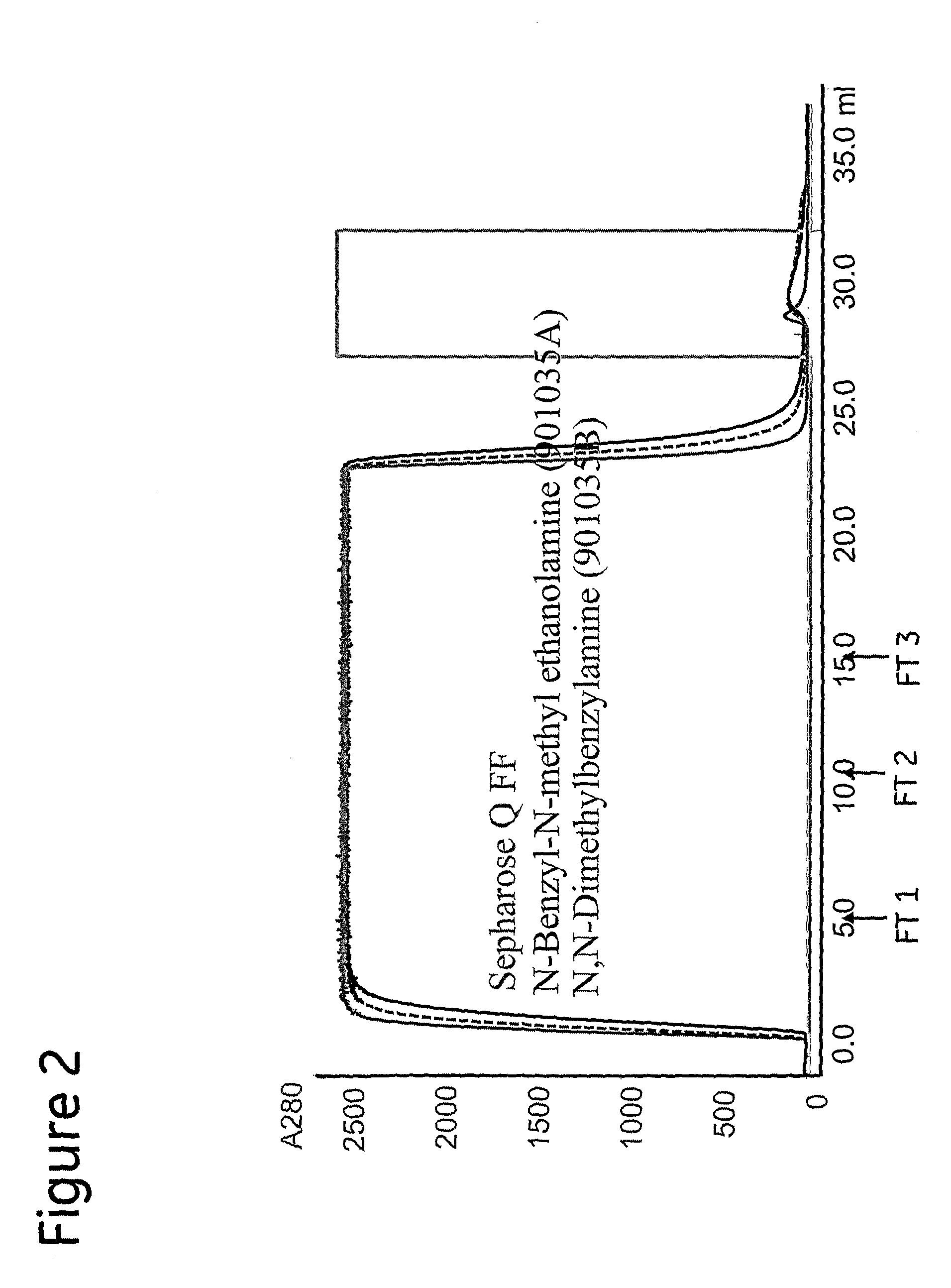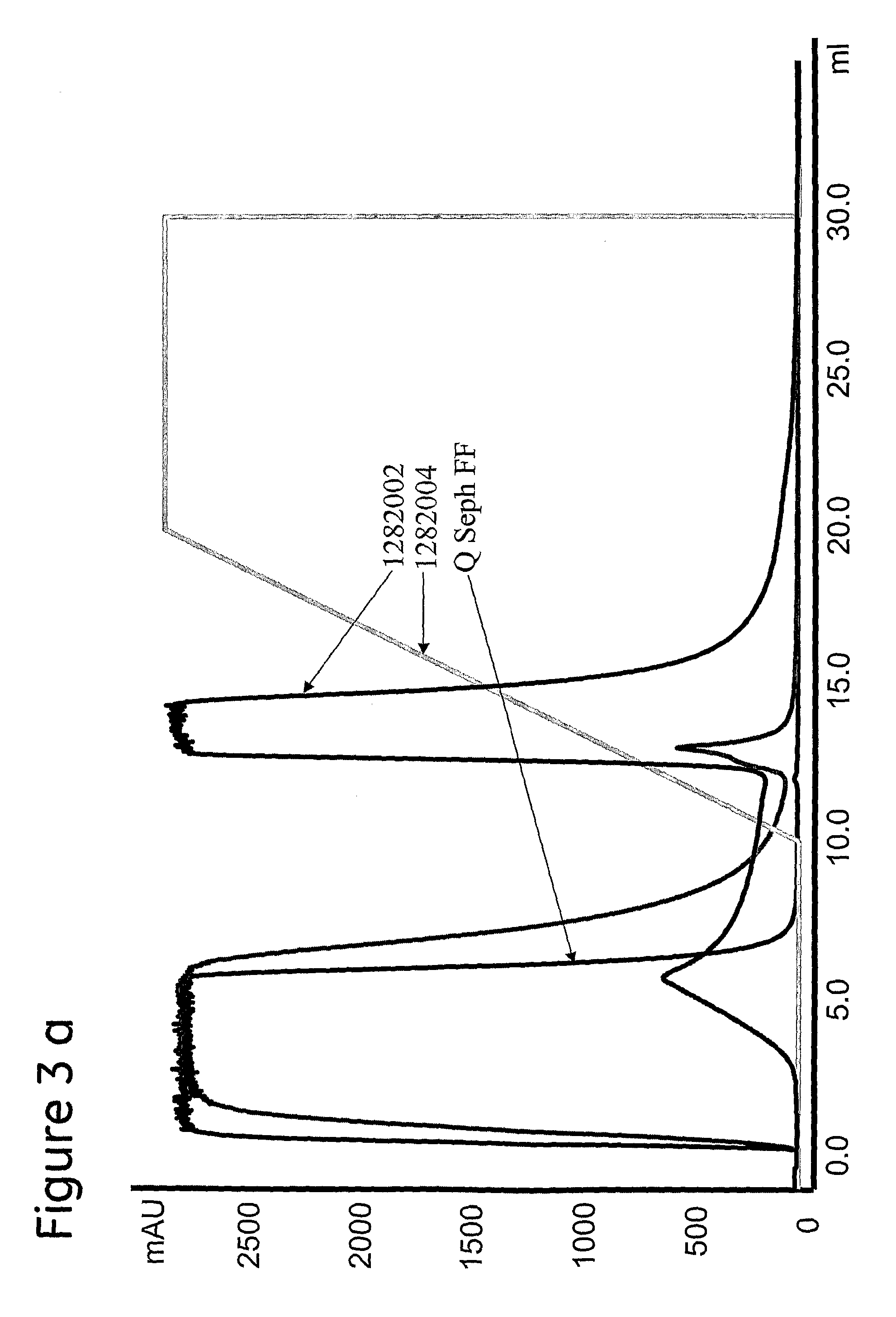Method of antibody purification
a technology of purification method and antibody, which is applied in the direction of separation process, instrument, peptide, etc., can solve the problems of time-consuming and laborious, impure products, and difficult to use the supernatant for other purposes
- Summary
- Abstract
- Description
- Claims
- Application Information
AI Technical Summary
Benefits of technology
Problems solved by technology
Method used
Image
Examples
example 1
MAb1-Containing Sample Purified on Prototype Ligands N-Benzyl-N-Methylethanolamine (901035A) and N,N-Dimethylbenzylamine (901035B)
[0103]In Example 1, sample containing 50 mg MAb1 was applied to N-benzyl-N-methyl ethanolamine immobilised on Sepharose™ 6 FF (901035A), N,N-dimethylbenzylamine immobilised on Sepharose™ 6 FF (901035B), and the reference matrix Q Sepharose™ FF in 25 mM Bis-Tris, 100 mM NaCl (˜12 mS / cm), pH 6.5. Elution was carried out with 25 mM Bis-Tris, 0.5 M NaCl, pH 6.5.
[0104]The chromatograms of example 1 are shown in FIG. 2, which shows the two prototypes N-benzyl-N-methyl ethanolamine Sepharose™ 6 FF (901035A) and N,N-dimethylbenzylamine Sepharose™ 6 FF (901035B) compared to Q Sepharose™ FF. Flow-through (FT) fractions selected for analysis are indicated with arrows. The results for HCP and Protein A clearance shown in tables 2 and 3 below reveal that the prototypes are superior to Q Sepharose™ FF in that respect.
[0105]
TABLE 2Results from HCP analysisStartFT1FT2FT3...
example 2
MAb 1-Containing Sample Purified on Prototype Ligands Thiomicamine and 2-Aminobenzimidazole
[0107]In this example, sample containing 20 mg MAb1 was loaded onto prototypes and reference separation matrices. Buffers were 25 mM Bis-Tris, 35 mM NaCl (˜5 mS / cm), pH 6.5 for equilibration and loading. Elution buffer was 0.5 M Na-acetate, pH 4.0. a) Thiomicamine, 65 μmol / mL (1282004), b) Thiomicamine 128 μmol / mL (1282002), c) Q Sepharose™ FF, d) 2-aminobenzimidazole (ABI), 65 μmol / mL (1282045) and e) 2-aminobenzimidazole (ABI), 146 μmol / mL (1282032). The results for the HCP and Protein A analyses are shown below in tables 4 and 5.
[0108]
TABLE 4Results from HCP analysisStartFT1FT2ColumnpH(ng / mL)(ng / mL)(ng / mL)Thiomicamine,6.5351≦10≦1065 μmol / mL (1282004)Q Sepharose ™ FF6.535111112-amino-benzimidazole (ABI),6.5351≦10≦1065 μmol / mL (1282045)
[0109]
TABLE 5Results from PrA analysisStartFT1FT2ColumnpH(ng / mL)(ng / mL)(ng / mL)Thiomicamine,6.50.390.000.0065 μmol / mL(1282004)Q Sepharose ™ FF6.50.390.090.212-a...
example 3
MAb2-Containing Sample Purified on Prototype Ligands Thiomicamine and 2-Aminobenzimidazole
[0110]Sample containing 20 mg MAb2 was applied to prototypes and reference. Buffer was 25 mM Bis-Tris, 100 mM NaCl (˜12 mS / cm), pH 6.0. Elution was performed with 0.5 M Na-acetate, pH 4.0. The resulting chromatograms are shown in FIG. 3. 3a) Thiomicamine (1282004), 65 μmol / mL, Thiomicamine (1282002), 128 μmol / mL and Q Sepharose™ FF. b) 2-aminobenzimidazole (1282045), 65 μmol / mL, 2-aminobenzimidazole (1282032), 146 μmol / mL and Q Sepharose™ FF. Analytical SEC was used to select fractions for the HCP and Protein A analyses as shown in tables 6 and 7 below.
[0111]
TABLE 6Results from HCP analysisStartFT1FT2ColumnpH(ng / mL)(ng / mL)(ng / mL)Thiomicamine,6.0170≦10≦1065 μmol / mL (1282004)Q Sepharose ™ FF6.01706655
[0112]
TABLE 7Results from PrA analysisStartFT1FT2ColumnpH(ng / mL)(ng / mL)(ng / mL)Thiomicamine,6.05.420.000.2465 μmol / mL (1282004)Q Sepharose ™ FF6.05.423.904.93
PUM
 Login to View More
Login to View More Abstract
Description
Claims
Application Information
 Login to View More
Login to View More - R&D
- Intellectual Property
- Life Sciences
- Materials
- Tech Scout
- Unparalleled Data Quality
- Higher Quality Content
- 60% Fewer Hallucinations
Browse by: Latest US Patents, China's latest patents, Technical Efficacy Thesaurus, Application Domain, Technology Topic, Popular Technical Reports.
© 2025 PatSnap. All rights reserved.Legal|Privacy policy|Modern Slavery Act Transparency Statement|Sitemap|About US| Contact US: help@patsnap.com



